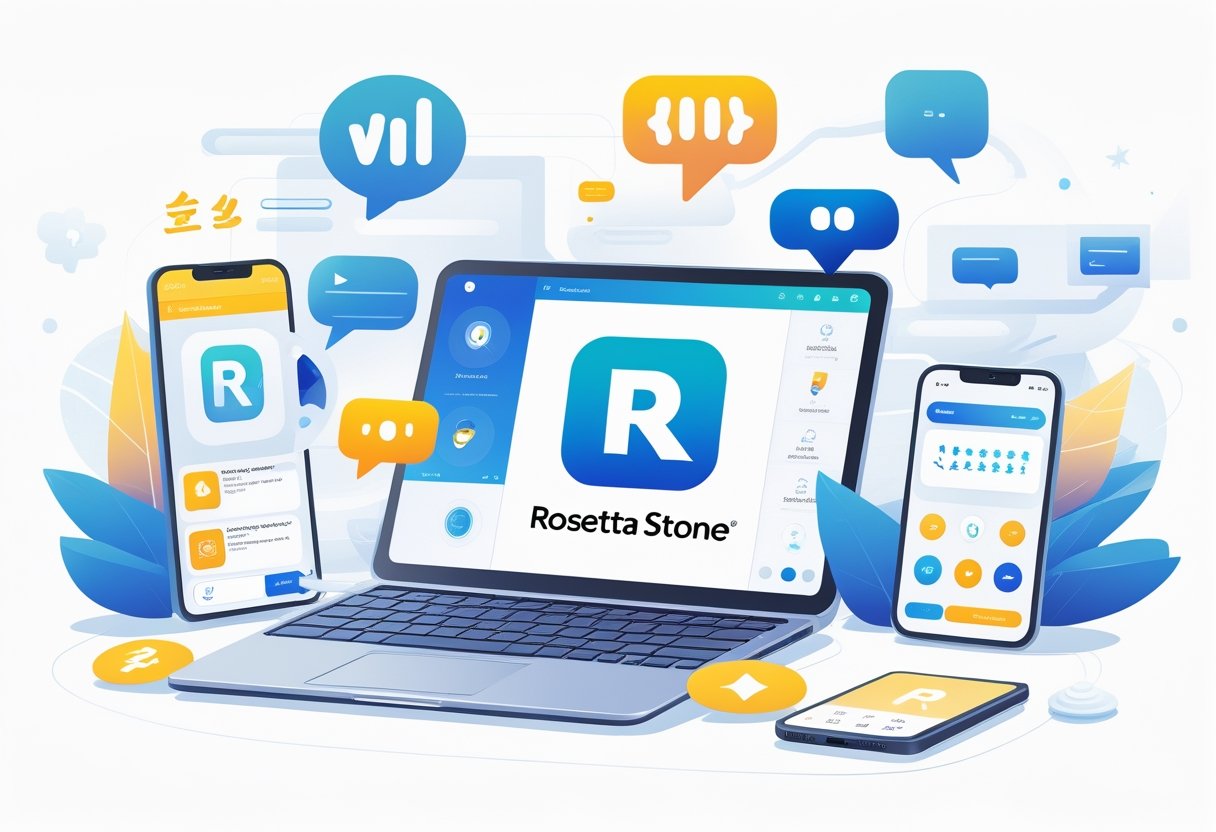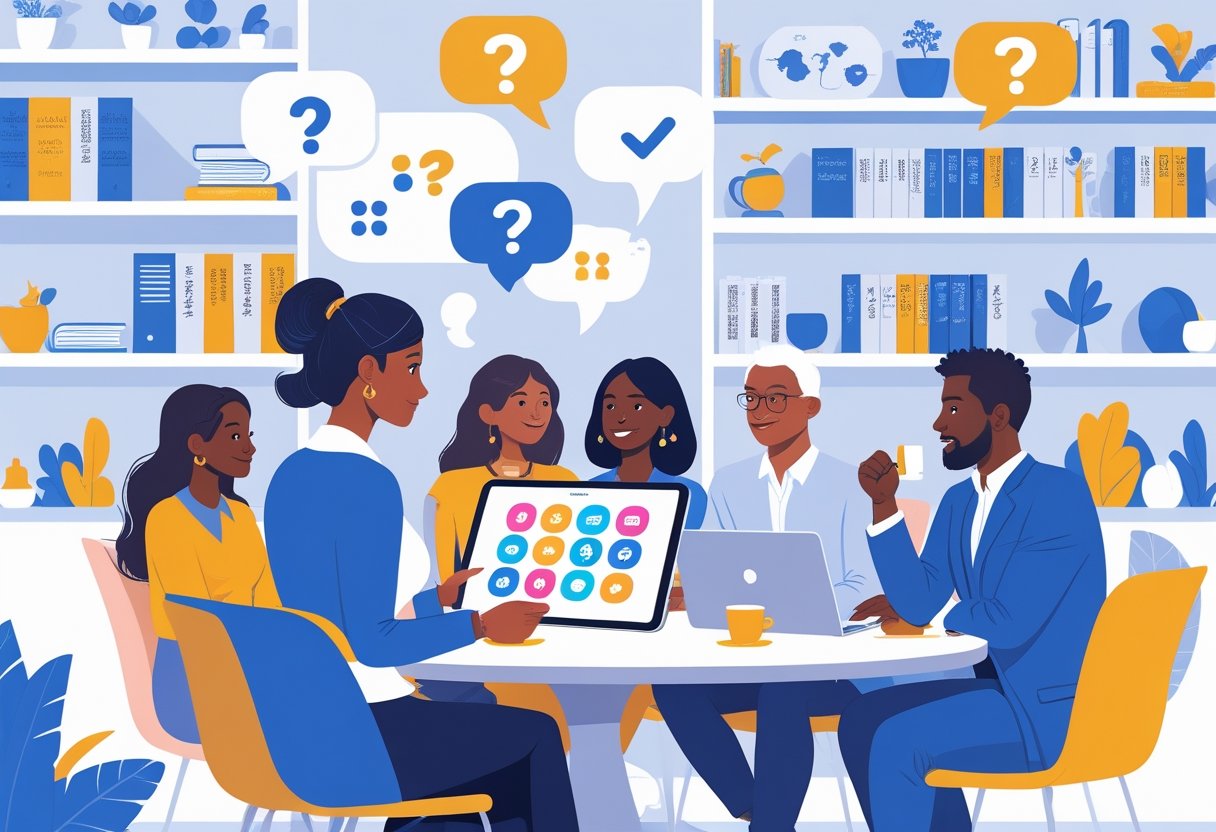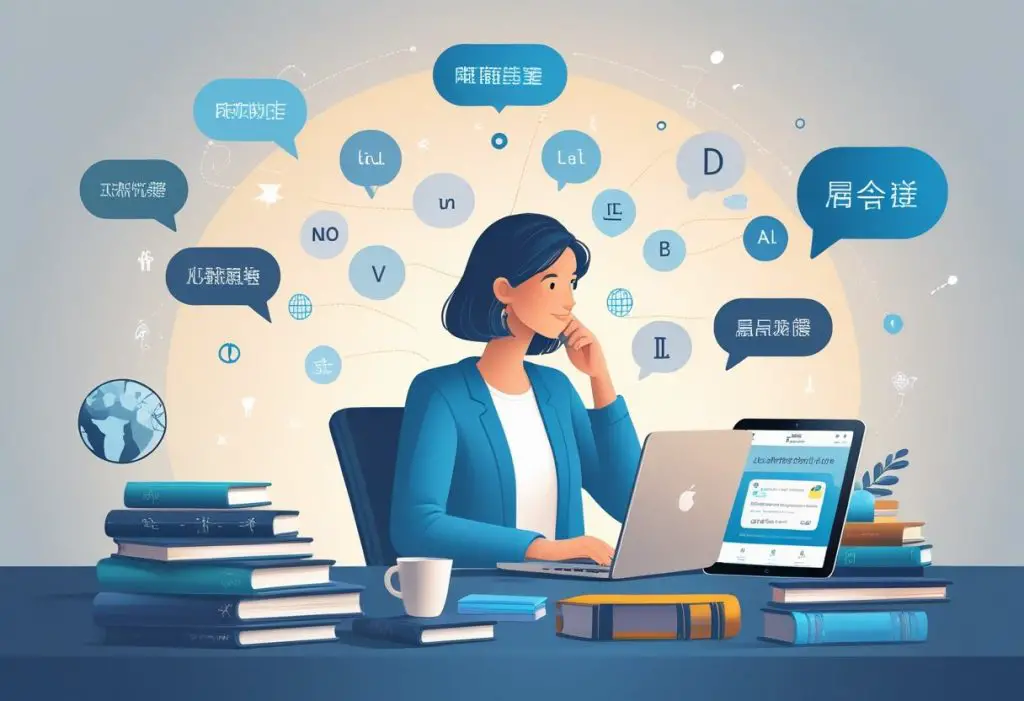Rosetta Stone has been around for decades, but many people wonder if it’s actually worth the money. The language learning app uses immersion-based methods and costs more than most competitors.
Using Rosetta Stone can really work and be worth it if you prefer structured learning without translations, but it may not suit everyone’s learning style or budget. The program works well for visual learners who like repetition. However, it lacks explanations of grammar and conversation practice.
Your decision depends on your learning preferences, budget, and language goals. Some users love the method while others find it boring or incomplete, considering language fundamentals.
Key Takeaways
- Rosetta Stone uses immersive learning without translations, which works better for some learners than others
- The subscription costs more than most language apps, but it offers structured lessons across many languages
- Success with Rosetta Stone depends on your learning style, with visual learners typically seeing better results
How Rosetta Stone Works
Rosetta Stone uses a method called dynamic immersion to teach languages without translation. The language app to learn offers courses in 25 languages with interactive lessons that build speaking, reading, and listening skills.
Dynamic Immersion Approach
Rosetta Stone’s dynamic immersive method teaches you a new language the same way you learned your first language. You won’t see any English translations or explanations during lessons.
The software shows you pictures paired with words and phrases in your target language. You make connections between images and sounds naturally. This helps your brain learn patterns without memorizing grammar rules.
Each lesson builds on what you learned before. You start with simple words like “boy” and “girl.” Then you move to phrases like “the boy is running.”
The software is good for learning as it uses speech recognition technology. You speak into your microphone and get instant feedback on your pronunciation. The app tells you if you need to try again.
Supported Languages
Rosetta Stone offers courses in 25 languages. Popular options include Spanish, French, Italian, and German. These are the most common choices for English speakers.
The language courses also cover Japanese, Korean, and Arabic. These languages use different writing systems from English.
Other available languages include:
- Dutch
- Greek
- Hebrew
- Hindi
- Irish
- Latin
- Persian
- Polish
- Russian
- Swedish
- Turkish
- Vietnamese
Each language course follows the same structure. The lessons adapt to the specific grammar and sounds of that language.
Learning Features and Course Structure
The Rosetta Stone app divides each language into units and lessons. Most courses have 20 units with 4 lessons each. Each lesson takes 30 minutes to complete.
Core lessons teach new vocabulary and grammar patterns. Focused activities let you practice specific skills like pronunciation or reading.
Key features include:
- Speech recognition for pronunciation practice
- Audio companion for listening on the go
- Stories to practice reading comprehension
- Live tutoring sessions with native speakers
- Offline downloads for learning without internet
The language learning software tracks your progress. You can see which lessons you’ve finished and your accuracy scores. The app sends reminders to help you study every day.
Extended learning features include group classes and unlimited live tutoring sessions. These cost extra beyond the basic subscription.
User Experience and Learning Outcomes

Rosetta Stone delivers mixed results across different skill areas, with stronger performance in some areas than others. The platform works better for certain types of language learners depending on their starting level and learning goals.
Speaking Skills
Rosetta Stone’s speech recognition technology helps you practice pronunciation from day one. The system listens to your voice and gives feedback on how close you sound to native speakers.
The speech tool works well for basic pronunciation practice. You repeat words and phrases while the program checks your accuracy. Most users find this helpful for building confidence in speaking.
Strengths in speaking practice:
- Real-time pronunciation feedback
- No pressure from human instructors
- Gradual difficulty increase
However, the speech recognition has limits. It focuses mainly on pronunciation accuracy rather than natural conversation flow. You won’t get practice with real back-and-forth conversations.
The program doesn’t teach you how to handle pauses, interruptions, or unclear responses. These are common parts of real conversations that Rosetta Stone can’t replicate.
Listening Skills
The listening component uses native speakers throughout all lessons. You hear authentic accents and natural speech patterns from the target language.
The audio quality is clear and professional. Speakers talk at normal speeds, which helps train your ear for real-world conversations. This approach works better than slowed-down or overly clear speech.
Audio features include:
- Multiple native speaker voices
- Natural speaking pace
- Clear pronunciation examples
Your listening skills improve gradually through repeated exposure. The program starts with single words and builds up to full sentences and conversations.
The main weakness is limited variety in listening contexts. Most audio comes from lesson scripts rather than real conversations, news, or casual speech.
Progress for Beginners and Intermediate Learners
Beginners see the most success with Rosetta Stone. The visual learning method works well when you’re starting from zero knowledge. New language learners often feel less overwhelmed compared to traditional textbook methods.
The program builds vocabulary steadily in the first few months. Most beginners can handle basic conversations about everyday topics after 3-6 months of regular use.
Intermediate learners face bigger challenges. The lack of grammar explanations becomes more noticeable as language rules get complex. You may feel stuck when trying to move beyond basic conversations.
The program doesn’t adapt well to learners who already know some of the language. Intermediate users often find the pace too slow and the content too simple for their needs.
Progress timeline for different learners:
- Complete beginners: Good foundation in 3-6 months
- False beginners: May feel bored with early content
- Intermediate users: Limited advancement beyond current level
Pricing, Value, and Subscription Options

Rosetta Stone offers monthly and yearly subscriptions with different access levels. You can also buy lifetime access to avoid recurring payments.
Subscription Costs and Lifetime Access
The Rosetta Stone app costs $11.99 per month for one language. A yearly plan drops the price to $5.99 per month when billed annually.
You get access to all 25 languages for $14.99 monthly. The annual unlimited plan costs $8.99 per month when paid upfront.
Lifetime access costs $179 for one language. The unlimited lifetime option is $299 for all languages.
Current Pricing Structure:
- Single language: $11.99/month or $71.88/year
- All languages: $14.99/month or $107.88/year
- Lifetime single: $179 one-time
- Lifetime unlimited: $299 one-time
The language learning software often runs sales. Discounts of 30-50% happen several times per year.
Payment Structure and Access Levels
All subscriptions give you full access to your chosen languages. You get the mobile app, web platform, and offline downloads.
Monthly plans let you cancel anytime. Annual subscriptions save money but require an upfront payment.
The basic subscription includes core lessons, pronunciation practice, and progress tracking. No premium tiers exist with extra features.
What’s Included:
- Mobile and desktop access
- Offline lesson downloads
- Speech recognition technology
- Progress syncing across devices
Lifetime purchases never expire. You keep access even if Rosetta Stone changes pricing or subscription models later.
Rosetta Stone Compared to Other Language Apps

Rosetta Stone costs more than most competitors but offers unique immersion-style learning. Popular alternatives like Duolingo, Babbel, and Pimsleur take different approaches to teaching languages.
Rosetta Stone vs. Duolingo
Duolingo is free with ads or $7 per month without ads. Rosetta Stone costs $36 per month or $179 per year.
Duolingo uses gamification with streaks, points, and levels. You complete short lessons that mix translation exercises with multiple-choice questions. The app explains grammar rules directly.
Rosetta Stone uses no translations or explanations. You learn by matching pictures with words and phrases. The method mimics how children learn their first language.
Learning Style Differences:
- Duolingo: Game-like, quick lessons, explicit grammar
- Rosetta Stone: Immersion-based, longer sessions, intuitive learning
Duolingo covers more languages (40+) compared to Rosetta Stone’s 25 languages. Both apps work on phones and computers.
Duolingo’s free version includes all lessons but has ads and limited features. Rosetta Stone requires payment for full access.
Rosetta Stone vs. Babbel
Babbel costs $14 per month or $84 per year. This makes it cheaper than Rosetta Stone but more expensive than Duolingo.
Babbel focuses on practical conversations you might actually use. Lessons teach phrases for travel, work, and daily life. Grammar explanations appear in your native language.
Rosetta Stone avoids your native language completely. You must figure out meaning through context and images.
Key Differences:
- Babbel: 14 languages, conversation-focused, clear explanations
- Rosetta Stone: 25 languages, immersion method, no translations
Babbel lessons last 10-15 minutes. Rosetta Stone sessions typically take 30 minutes or more.
Both apps include speech recognition technology. Babbel’s pronunciation practice is less intensive than Rosetta Stone’s speaking exercises.
Rosetta Stone vs. Mondly, Memrise, and Pimsleur
Mondly costs $10 per month and teaches through virtual reality and augmented reality features. Memrise offers a free version with paid premium features at $15 per month.
Pimsleur focuses entirely on audio learning. It costs $20 per month and emphasizes speaking from day one. Lessons are 30 minutes of pure listening and repeating.
Price Comparison:
- Mondly: $10/month
- Memrise: Free or $15/month
- Pimsleur: $20/month
- Rosetta Stone: $36/month
Memrise uses spaced repetition to help you remember vocabulary. Videos show native speakers using real phrases in natural settings.
Mondly includes chatbots and voice recognition. The language app covers 41 languages with interactive lessons.
Pimsleur builds speaking confidence faster than visual apps. Rosetta Stone combines visual and audio learning but costs significantly more than these alternatives.
All these apps offer mobile learning. Your choice depends on your budget, learning style, and time commitment preferences.
Frequently Asked Questions

Rosetta Stone users often ask about real-world effectiveness and whether the program delivers fluency. Cost comparisons with other language apps and learning outcomes are common concerns.
How effective is Rosetta Stone for learning a new language?
Rosetta Stone works well for building basic vocabulary and pronunciation skills. The immersion method helps you think in your target language without translating from English.
What advantages does Rosetta Stone offer over competitors like Duolingo or Babbel?
Rosetta Stone uses no English explanations during lessons. This forces you to learn through context and visual connections. Duolingo focuses more on gamification and short daily practice. Babbel explains grammar rules directly in English.
Can users become fluent with Rosetta Stone software on their own?
Rosetta Stone alone will not make you fluent in a language. No single program can replace real-world practice and conversation. You will reach a conversational level for basic topics. The program covers everyday situations like shopping, dining, and traveling. Advanced grammar concepts get limited coverage in the lessons. You will need additional resources for complex language structures.
What is the cost-benefit analysis of investing in Rosetta Stone for language learning?
A lifetime subscription costs around $200 during sales. Monthly plans cost $12 per month for one language. This price includes access to mobile apps and computer software. Live tutoring sessions add value but have limited availability.

